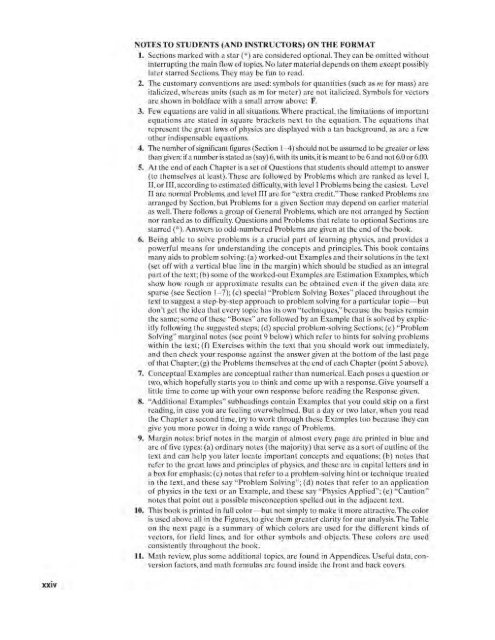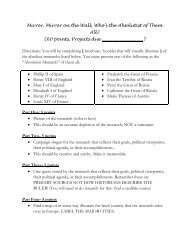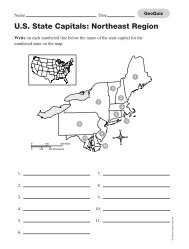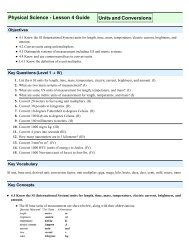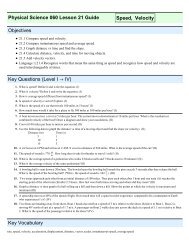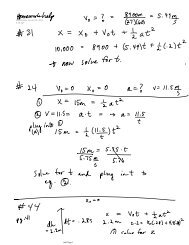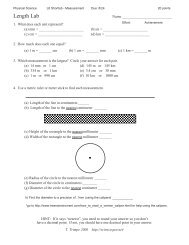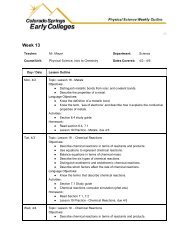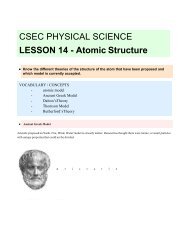arc considered optional. They can be o
arc considered optional. They can be o
arc considered optional. They can be o
- No tags were found...
Create successful ePaper yourself
Turn your PDF publications into a flip-book with our unique Google optimized e-Paper software.
NOTES TO STUDENTS (AND INSTRUCTORS) ON THE FORMATL. Sections marked with a star (-) <strong>arc</strong> <strong>considered</strong> <strong>optional</strong>. <strong>They</strong> <strong>can</strong> <strong>be</strong> omilled withoutinlcrrupting th~ main flow of topics. No later material depends{H1them eXCl'pt possiblylater starred Sections. <strong>They</strong> may <strong>be</strong> ftm to r~ad.2. The customary conventions <strong>arc</strong> used: symbols for qUJntities (such as /II for mass) areiwlicized, whereas units (such as m for meter) <strong>arc</strong> not italicized. Symbols for vectorsare shown in boldfaCt: with a small arrow above: F.3. Few equations are valid in all situations. Where practical, the limitations of im portantequations <strong>arc</strong> stated in square brackets nexi 10 the eqU
USE OF COLORV\.'t:l ors"" "lIB' ,'U'n", ' "'0) ;, ,Iiglt'ly 'h~' ~crromp"'.'o" of .... y \'f ' -Okl
This CQnlpUlcr-coh;.occd pholO ul Earlh was la~cn frun'aboul 36.000 ~m away. Norlh and SoUlh America <strong>arc</strong>clearly visible IJclu", the cI"ud
FIGURE 1-1 ,\rillQtlc is thecentral figu re (dress.ed in blu~) atthe top 01 the stairs (th~ figure nextto him is Plat,,) in this famuusRenaissance I'Onrayal of T/!,'SchO
", , ,•,•(a)FIGURE 1- 2 (aJ 1' lOlcmy"~ geocemric \";cwof the unh'~""', NOle .llhe ccnl~f the fou , dements of Ih<strong>can</strong>ci~nlS: Earth. "-ateL air (douds around the Earth), and fire: then the cirdes. "'jth symbols. for lh~ Moon.Mercur)'. Venus. Sun. M;>!"S- Jupiter. Saturn. Ihe fi'Crl stars. and Ihe signs of InC 7.odia,. (h) An carl)' rcpresent.lionof Copernicus's heliocentric "ie'" of the universe with the Sun al the center. (Sec Chapler 5.)("'lheory. BUI in many cases. a new thwry is accepted only if it explains a greaterrtlnXe of phenomena lhan docs the older one. Copernicus's Sun-centered th~ oryof Ihe universe (Fig. 1- 2b). for example. was originally no more accurate thanl'tolcmy"s Earth-ccntcrcd theory (Fig. 1- 2a) ror predicting the motion of Ileav.en ly bodies (Sun. Moon. planets). But Copernicus's theory had oonsequen(Xsthat Ptolemy's did not. such as predicting th e moonlike pllases of Venus. Asimpler and richer th eory. one which unifies and explains a greater variety ofphenomena. is more useful and bcall1iful 10 a scientist. And this aspect. as wellas quantitmivc agreemeil1. plays a major role in the acceptance of a theory,An important aspect of any tlleory is how well it <strong>can</strong> quantitat ively predictph~nomena. and from this point of view a new theory may often seem to <strong>be</strong> only" minor adv;lIlce over the old one. For n"mple. Eill8tein-s theory of rd"t;vitygi"es predictions that differ wry li(tle from the older lhcorits of Galilco .1ndNewton ;11 Ilcarly all everyday situ"tions. I\s predictions <strong>arc</strong> <strong>be</strong>tter m"inly in thee ~tr em e case of \'C ry high spceds clo~e to Ihc speed of light. Rut qU;lIllitativeprediction i, not the oll ly importallt outcome of a theory_ 0 ur ,-iew of the worldis "frected :18 well. A:; a result of Ein~ tein'~ theory of rel"I;"ity. for example, Ollrconcepls of 8pace and time have <strong>be</strong>ell completely :.ttered, :md we h:I\'c come 10see m;lS:; and energy:l>:> sillgle tlltit)' (via the f"mous equ'llion E = m,')_FIGURE 1-3 SlUdi~s()n {he f"rc~s,n ~ ('UClU'CS b)" u:on",do da Vinci(U52-1519),and its Relation to Other FieldsFor a long time science was more or less a united whole known as naturalphilosophy. NOl until a century or IWO ago did Ihe distinctions <strong>be</strong>tween physicsand chemistry and even the life sciences <strong>be</strong>eome prominent. Indeed. the sharpdistinction we now sec <strong>be</strong>tween the arts and the sciences is itsclf but a fewcenturies old. It is no wonder th en thm the dewlopment of physics has bothinfluenced and <strong>be</strong>en influenced by olher fields. For example. the notebooks(f ig. 1- 3) of Leonardo da Vinci. the great Renaissance artist. rcseareha. andengineer. contain the tirst references to the forces acting within a structu r ~. asubject we consider as physics today: but then. ns no\\'. i1 has grcal relevance to<strong>arc</strong>hitectufe a nd building.pIncr?_ 1",-l,SECTION 1- 2 Physics and its Relation to Other Fields 3
The purpose of a model is to give U'i all "pproxima\c mCIlI,,1 or \'i8u,,1piclure-80melhillg to hold ollto-whell we C,lIl ll01 sec or under,t;md wh;,tactually is h"ppening. Model8 often gi"e u, a dee[>
Srarong /h~ uIKmimyAssumed ""ur/(JilllyWhen giving the result of il meilsu r ~menl, it is im port'lnl to st,'le Ihe u ti.mated uncertainty in the mea>uremenL For e~il mplc, the widlh of;l bo;lrd mighl<strong>be</strong> written ;IS 8.8 ± O. t em. The ± 0,1 em ("plus or minus 0.1 em") repro.urement, so thilt the ildu;ll widlh most likelylies <strong>be</strong>lween 8.7 and 8.9em, The percent uncertainly is simply the r;Jrio of theunecrtilinty to the measured v;Jlue, multiplied by tOO. For e~ilmple, if the me,lSurementis 8.8 ,lnd the unccrtairl\y aboul 0.1 cm, the pe re~rl\ uncert;Jinty is0.1- X 100% "" 1%8.'where '" means ~is roughly equal to."Of len the uncertainty in a measured val ue is nOI spi'cificd explicitly. In suchcases, Ihe uncertainty is generally assumed to <strong>be</strong> one or a few unils in Ihe laSIdigit specified. For example. if a length is given as 8.8cm. the uncertainty isassumed 10 <strong>be</strong> about 0.1 em or O.2cm.lt is importanl in this case that you do nOIwrile 8.SOem, for this implies an uncertainly on Ihe order of 0.01 em; il assumesIhal the lenglh is probably <strong>be</strong>tween 8.7gem and 8.81 em. when actually yo u<strong>be</strong>lieve it is <strong>be</strong>tween 8.7 and 8.9cm.CONCEPTUAL EXAMPLE 1-1 Is the diamond yours? A friend asks toborrow your precious diamond for a day to show her family. You Jre a bilworried. so you carefully have your diamond weighed on a s.cale which reads8.17 grams. The scale's accu racy is claimed to <strong>be</strong> ± 0.05 gram. The next day youweigh the relurned diamond again, getting 8.09 grams. Is this your diamond?RESPONSE The s.cale readings <strong>arc</strong> measuremenlS and do not necessarily givethe "true" value of Ihe mass. Each meJSuremenl could have <strong>be</strong>en high or lowby up 10 0.05 gram or so. The actual mass of you r diamond lies most likely<strong>be</strong>tween 8.12 grams Jnd 8.22 grams. The aClual mass of Ihe returned diamondis most likely <strong>be</strong>tween 8.04 grams and 8.14 grams. These IWO ranges overlap, sothere is nOI a strong reason to doubt that Ihe returned diamond is yours, atleast based on the s.cJIe reJdings._ PROBLEM SOLVING.'>'lIm<strong>be</strong>r of signifieo," figllres in fi/Ullres,,11 should <strong>be</strong> SlIme os leas/signifi<strong>can</strong>t inpou ,,,,/,,e6 CHAPTER 1Signifi<strong>can</strong>t FiguresThe num<strong>be</strong>r of reliably known digi\.s in a num<strong>be</strong>r is cillled the num<strong>be</strong>r of~ ignifi ca nt figurl"S. Thus there ilr~ four signifiCilnl figures in the num<strong>be</strong>r 23.21 cmilnd two in the lIum!J.t, r 0.062 cm (the 'l.eros in the Iilller ,lie merely plilee holdersthill show whe re the decimill point goes), The num<strong>be</strong>r of signifiC;lnt figures m;Jynot alw;Jys <strong>be</strong> ck;lr. Take, for e' ilm ple, the lIum<strong>be</strong>r SO. Arc Ihere one or twosignifi<strong>can</strong>l figures? If we say it is ilIJ01I1 80km <strong>be</strong>tweell two cities, Ihere is onlyone signifi<strong>can</strong>t figure (the 8) since Ihe ze ro is merely a place holder. If it isHilelly 80 km within an accuracy of 1 or 2 km, then the SO has IWO signifi<strong>can</strong>lfigures. ' If il is precisely RO km, to within ± 0.1 km, Ihen we write RO.O km.When making mea\urement~ or when doing calculations, you should avoidthe lemptation 10 kee p more digits in Ihe final answer than is juslified. Forexample, to calculate the area of a rectangle 11.3cm hy 6.8cm, the result ofmultiplication would he 76.84cml. But this answer is clearly not accurale 100.01 cm 1 , since (using the outer limits of Ihe as.~umed uncertainty for eachmeasurement) the result could <strong>be</strong> <strong>be</strong>tween 11.2 em x 6.7 em = 75.04 cm 1 andII.4cm x 6.9cm = 78.66cm 1 . At <strong>be</strong>st. \\"e <strong>can</strong> quote the answer as 77C111 1 ,which im plies an uncertainly of about 1 or 2cm 1 . The olher IWO digits (i n thenum<strong>be</strong>r 76.84cm 1 ) must <strong>be</strong> dropped sillce they <strong>arc</strong> not signifi<strong>can</strong>t. As a roughgeneral rule (i.e., in the absence of a detailed cOllsideration of uncertainties), we<strong>can</strong> say that Ihe final resufl of a ",ulliplictlliOIl or divisioll sllOfiM have only asmally digilS as Ihe num<strong>be</strong>r ,villl lire leasl num<strong>be</strong>r of signifi<strong>can</strong>t figures used ill lirecalmlillioll. [n our example, 6.8cm has the least num<strong>be</strong>r of signifi<strong>can</strong>t figures.namely t\\"o. Thus Ihe resolt 76.84 cm 1 needs to <strong>be</strong> ro unded off to 77 cm 1 .' If tho 80 has Iv.'(> ,ignofo<strong>can</strong>t figu,o,"."mc pcw tc r refor 10 ""ito il 8!J. v.'ilh • docomal roin l. Thi, i,not u,u.lly done. '" 'he num!>
EXERCISE A The area of a reetangle ~.5 em by 3.25 em is correctly given byI (a) 1~ . 62jem' : (b) 1~ . 63cm' ; ( c ) 1 ~ . 6cm':(") IScm'.When adding or subtracting nUmb~fs. the final result is no more acc uratethan th e least accurate num<strong>be</strong>r used. For examp le. the result of subtract ing 0.57from 3.6 is 3.0 (and not J.OJ).Keep in mind when you usc a c:llculator th;lt all the d i git~ it produce~ maynot I:>e ~ignific;lnt. When you divide 2.0 by 3.0. the proper ~nswer is 0.67. ;md nolsome such th ing
Units, Standards, and the 51FIGURE 1-8 Some lenglhs:(a) "irus~s (ahOlil 10- 7 m long)allading" ~clL(b) MI. EWr"'I',heighl is on Ihe order of 10' In(885On"to he pr~d se )Th~ m~
TABLE 1 -2 Some Typical Time IntervalsTABLE t-3 Some MassesTirn ~ Inl ~ " ' al Seconds t .p pro~irnal ~ ) Objeci Kilograrns ( appro ~ irnal e)Liletirne of very unstable subalornic parlieie 10 V S EleClron 10 )() ~gLifelime of radioactive dements 10-ll S to lo>S~ Proton. neulron 10- 11 kgLilelirne 01 rnuon W· , [)NA rnole
TABLE 1-5 SI Base Ouantitiesand Units51 unils <strong>arc</strong> Ille principal ones used tod;IY in scie fl lific work. We willtncreforeusc 51 uflits ill most e ~ clusi,'cly in lllis book. although we will give Ille cgs-'::c:..::::"''--______ -;,-, __ ;lIld Rrili,h unil, for various quanlilies when inlroduced.UnitAbb,~ · Base VS. Derived QuantitiesQua"tity Unit .iati"" Physical quanlili~s <strong>can</strong> ],.-, di\'id~d into two categories: b,ue q"''''li(ie,< andLen gth meIer mden'~ed 'I",,,,(ilies. TIle curresponding units for Ihese quanlities <strong>arc</strong> called huseTimes
equali{Hl \0 find the num<strong>be</strong>r o f fect in 1 meier:If'I m = 0 04 = 3.2S084 fl..3 8We multiply this cqU:llion by 8JXX1.O (10 have five signific;lnl figu res):8JlOO.O m = (8,000.0 "m..)( 3.2R0S4 :) = 26,247 ft.An elevation of 8000 m is 26.247 ft a" ol'"" sea level.NOTE We could have done the conversion all in one line:8000m = (8000'm..) ( 'OO-)( li1'1_ )(~) = 26.247f1.1 'm.. 2.S4~ 12 l'fi...The key is \0 mulliply conversion faclors. each equal to one (= 1.0000). and toma ke sur.: the Ull ilS <strong>can</strong>cel.EXERCISE D The,e are o nl~' 14 e;!',hl -thousand-meler peak. in the world (seeE~.'n ' ple 1- 3) and their nameS and cic'-a(ions <strong>arc</strong> giwn in Table 1- 6. <strong>They</strong> are all inthe Himalaya mountain range in India. Paki'tan. Ti<strong>be</strong>t. and China. Determine thedevalion of {he world', three highest peah in feeLTABLE 1-6 The aooO-m PeaksPea~Ml. EverestK2KangchcnjungaLhOls
m Order of Magnitude: Rapid Estimatingw~ ar~ somdimes inl~rcswd only in an approximate \'ulu~ for a quantity. Thismight <strong>be</strong> <strong>be</strong>cause an "~1.'urak ,"akulation would take mor~ li me than it is wDrtll orwould require additional data thaI <strong>arc</strong> not al'ailable. In olher cases, We may want \0mah a rough eSlim"te in order \0 check an acrurak calculation nmdc on a calculatoT,\0 make sure lhal no blunders Were made when the numbt.rs wer" entered ... PRO B l EMS 0 till N G A rough eSlimate is made by rounding off all numocrs \0 one signifi<strong>can</strong>tH
NOTE To eJCpre'\.S our resuh in Us. g,lllons, W~ so:~ in Ihe Tilbk on lhe insidefronl cowr lh,J( llikr = 10 .lm l "" ~g;'lIon. Htnce, Ihe lah conl"in8( lO'm'XI gallon/ 4 x 1O-' m') "" 2 x 10" g"lIons ofw;Oler.EXAMPLE 1- 7 ESTIMATE Thickness of a page. ESlimJle lhe Ihic~ - .. P RO B l (M SOL v I N Gness of" page of lhis book.APPROACH At firsl you might think Ihal U sp"cial m~asuring d~\'ice. amieromekr (Fig, I-II), is needed 10 m~asur~ th~ thickness of one page sincean ordinary ruler dearly won'l do. But w~ <strong>can</strong> uS you, and Ihe Olher touches Ihepok SO you eSlimak Ih"l dislance as 2 m (Fig. J -12a). You Ihen pace off Ih~diSlance from Ih~ pole 10 th~ base of Ihe building Wi1h big, I·m-Iong. sleps andyou gN a Inial of 16 sleps or 16m,SOLUTION Now you draw. 10 sc"le. Ihe di;lgr;lm ,hown in Fig. 1-12b usingIhcse me",u r em~nts. You <strong>can</strong> me
dimension;,1 checks. We write a dimension;,1 equation as follows, remem<strong>be</strong>ringthat the dimensions of speed <strong>arc</strong> [L /T) ;lIId (as we sh;,11 sec in Chapler 2) thedi mensions of acce leration <strong>arc</strong> I L/T']:[fj J. [¥j + [~, jIT'1J. [~T' j + [L),The dimensions <strong>arc</strong> incorrect: on Ihe right ,ide, we have the sum of quantitieswhose dimension, <strong>arc</strong> not the S
1-7 Order 01 Magnitude Est imet ing~Nole: Remem<strong>be</strong>r that for rough estimates. onl~' round num<strong>be</strong>rs<strong>arc</strong> needed ooth as inrul to calculations and as ronal resuhs.)~4. (I) Estimate the order "f magnitude (P
42. An :"'cTage family of four uses roug hl y 1200 li(ers (ahou(.lOIlgallo",) of waler per day. (Oneliler 5 UXXlcm'.)How much delHh wo uld n lah k~ Pdjaccol molecules jusltouching. eSlimalc the di.meler of Ihe oil slick. AssumeIh~ oil mol~eulc, ha"c a diameter of2 X 10 10 m." .51.52.kan cam fJS <strong>be</strong>sid~ a wide rivcr and "'noders h"w "'ide ili .. She SpolS a large rock on th e bank directly aero .. fromher. Shc Ihen wa lk s u pSlr~a m unlil 'he judges Ihat Ih~angle bclween her a nd the rod. which she CHn still secclearly. i, no'" at a n angle of J()" dO"'nstream (Fig. 1-17).JC;ln "'e,.. ureS her stride 10 <strong>be</strong> aboul one yard long. Thed islance back to her camp is 12Uslride~ ,\ bo Ul how faracross. bolh in yard, and in md~'" i, the river?, , , , ,.. , ,, N''"', , ," FIGURE 1- 17I'roblem 49.,\ "'aleh manUfatlllrer claim' that ils watches gain orIme no more Ihan ~ second, in a year. H"w accurale i,this walch. exprcs,cd as a percentage?The diameler of Ihe M""n is 3480 ~m . Whal is Ihe ,'"Iumeof Ihe Moon' How many Moons would he needed 10creale a "olume e'lual 10 Ihat of Earth?An angSlrom (s)"mbol A) is a unil of lenglh. defined asIO-''' m. ""hich is on the order of the diameler of an alom.In) How many nanomders are in 1.0 ang'trom? (b) Howma1\)' fem(metcrs or ferm is (Ihe COmmon unit of lenglhin nuclear physics) are in 1.0angslrom·! (e) Ho"" man~'nns'troms <strong>arc</strong> in 1.0 melcr? (,/) How m.nj· M gstroms <strong>arc</strong>in I.U light·year (sec Problem 22)?D el~rm ine Ih~ jk":ent unC ~rl ainll" in d. and in sin 1/ .... hen(n) 8 = 15.0' ± OS. (b) 1/ = 75.0" ± 0.5.If you !>egan walking along one of Earth's lines oflongitude and walked unlil you had changed lalitude by1 minute of <strong>arc</strong> (there <strong>arc</strong> 60 minut~s jkr degree). ho'" farwould you h,..-e walked lin miles)' This diSla nce is c;llieda "nau!ical mile:'Answers to ExercisesA: (d).8: No: 3. 2.C: Alllhree have Ihree 'ignifiear1( figures. alihough Ihenum""r of decimal places is (nl 2. (h) 3. (c) ~.U: M I. E \"Cr~st. 29.035 flo K2. 28.25 1 It: KangchenjungJ.2ll.169ft.E: No 15 mls '" :l4 milh18 CHAPTER 1 In troduction, Measurement, Estimating


